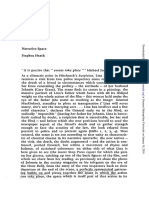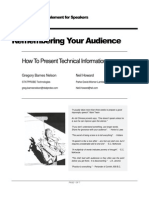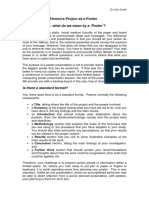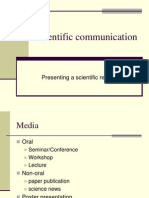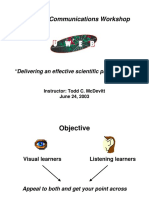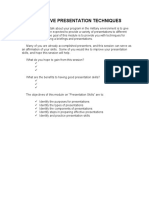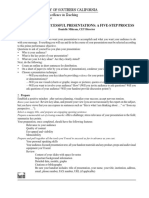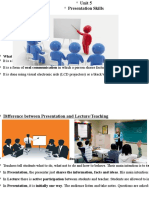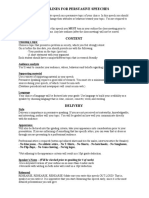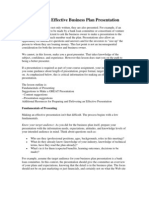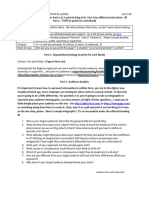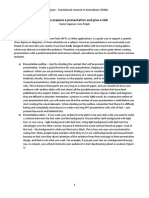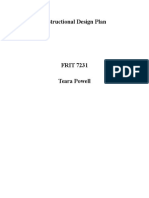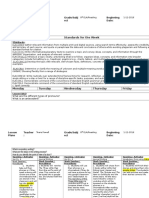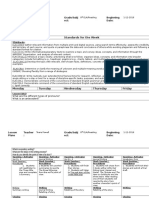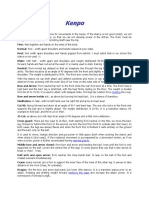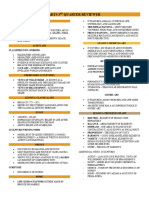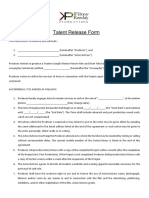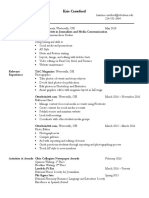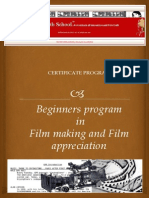0 ratings0% found this document useful (0 votes)
61 viewsConflict in The Real World - Advanced Reading Mini-Project
Conflict in The Real World - Advanced Reading Mini-Project
Uploaded by
api-310131918Students must create a visual display or presentation about real-world conflicts. They must include one example of an internal conflict and four examples of different external conflicts, sourced from current events, history, or other factual contexts. The presentation must define key terms, illustrate each conflict example with a brief summary, and cite sources in a bibliography. Formats can include a poster, tri-board display, PowerPoint, or handbook. Specific guidelines address layout, design, organization, and oral presentation skills for evaluative purposes.
Copyright:
© All Rights Reserved
Available Formats
Download as DOCX, PDF, TXT or read online from Scribd
Conflict in The Real World - Advanced Reading Mini-Project
Conflict in The Real World - Advanced Reading Mini-Project
Uploaded by
api-3101319180 ratings0% found this document useful (0 votes)
61 views2 pagesStudents must create a visual display or presentation about real-world conflicts. They must include one example of an internal conflict and four examples of different external conflicts, sourced from current events, history, or other factual contexts. The presentation must define key terms, illustrate each conflict example with a brief summary, and cite sources in a bibliography. Formats can include a poster, tri-board display, PowerPoint, or handbook. Specific guidelines address layout, design, organization, and oral presentation skills for evaluative purposes.
Original Title
conflictintherealworldrubric
Copyright
© © All Rights Reserved
Available Formats
DOCX, PDF, TXT or read online from Scribd
Share this document
Did you find this document useful?
Is this content inappropriate?
Students must create a visual display or presentation about real-world conflicts. They must include one example of an internal conflict and four examples of different external conflicts, sourced from current events, history, or other factual contexts. The presentation must define key terms, illustrate each conflict example with a brief summary, and cite sources in a bibliography. Formats can include a poster, tri-board display, PowerPoint, or handbook. Specific guidelines address layout, design, organization, and oral presentation skills for evaluative purposes.
Copyright:
© All Rights Reserved
Available Formats
Download as DOCX, PDF, TXT or read online from Scribd
Download as docx, pdf, or txt
0 ratings0% found this document useful (0 votes)
61 views2 pagesConflict in The Real World - Advanced Reading Mini-Project
Conflict in The Real World - Advanced Reading Mini-Project
Uploaded by
api-310131918Students must create a visual display or presentation about real-world conflicts. They must include one example of an internal conflict and four examples of different external conflicts, sourced from current events, history, or other factual contexts. The presentation must define key terms, illustrate each conflict example with a brief summary, and cite sources in a bibliography. Formats can include a poster, tri-board display, PowerPoint, or handbook. Specific guidelines address layout, design, organization, and oral presentation skills for evaluative purposes.
Copyright:
© All Rights Reserved
Available Formats
Download as DOCX, PDF, TXT or read online from Scribd
Download as docx, pdf, or txt
You are on page 1of 2
Conflict in the Real World - Advanced Reading Mini-Project
Assignment Prepare a visual display / presentation of real-world conflicts. Be sure to include
examples of both internal (1 type) and external conflicts (4 different types).
Display Options:
1) Full-Sized Poster 2) Tri-Board Display 3) PowerPoint 4) Handbook
Basic Requirements for ALL Displays Posters, Display Boards, & Powerpoint:
1) Title & Your Name
2) Definitions of Conflict, Internal Conflict, & External Conflict
3) 1 Example of Internal Conflict Label as Internal Conflict / Character vs. Self.
4) 4 Examples of External Conflict Label as External Conflict / ___________ vs. _____________
Include 4 different TYPES of external conflict.
5) Include factual conflicts found in the REAL WORLD not fictional examples from literature, film,
music, art, etc.
6) Include examples from a variety of fields, such as international affairs, government, politics, history,
business, science, medicine, education, sports, etc. Examples may be from current events or from
history.
7) Provide evidence or documentation that the conflict exists (newspaper or magazine headline/article,
Internet article, a clear photo with a caption, etc.) DO NOT JUST MAKE UP CONFLICTS! You must
conduct research & FIND examples. You MAY have 1 everyday type of conflict that you make up,
but it must be clear to everyone that this example often exists in the real world
8) Illustrate each example of conflict (5 illustrations total).
9) Provide a brief summary of each example provided. (Who is involved in the struggle? What do they
want or need? What Is the dilemma or problem? What obstacles hinder a positive resolution?
Was the conflict resolved, and if so, how?) You may include the summaries as part of the display
(e.g., index cards) or hand in the index card summaries. Do not crowd posters, tri-boards, or ppts!
10) Include a bibliography that lists ALL the sources where you found you examples.
Additional Expectations for Posters & Display Boards: NEATNESS COUNTS!
1) NO pencil or pen Use markers or type information in a large point-size are all right.
2) Any handwritten letters must be printed neatly and as uniformly as possible.
If in doubt, type using a large point size or use a stencil or commercial letters.
4) Balance and organize your display. Make wise use of the entire space. Space items properly.
5) Use color to make your display attractive.
6) Consider matting pictures on construction paper or print with a border.
7) BE CREATIVE! Do something to make your posters stand apart in a good way!
8) Most important: Make sure that the information on your display is clear and easy to understand.
ASK: Does the display clearly convey 1) the meaning of conflict, 2) the 2 major types of conflict,
and 3)examples of both internal and external conflict in the real world???
Additional Expectations for Powerpoint Presentations: NEATNESS COUNTS!
1) 8-12 slides Print out all slides (2 per page) and staple. Be sure to put your name on 1 slide. Your
bibliography should be on the final slide.
2) Organize your presentation. Present information in a logical order.
3) Choose font and point-size wisely. Use space wisely.
4) Use color to enhance your presentation.
6) Use some animation, but do not over-animate to the point of distraction.
7) BE CREATIVE! Do something to make your posters stand apart in a good way!
8) Most important: Make sure that the information on your display is clear and easy to understand.
ASK: Does the slide show clearly convey 1) the meaning of conflict, 2) the 2 major types of
conflict, and examples of both internal and external conflict in the real world???
Due: ___________ (Up to 2 Days Late10 pts off per day / Project will NOT be accepted >2 days late!)
Counts: 1 Test Be presented to present to class on ______________. Counts: 3 Dailies
SEE Project Checklist for evaluation criteria for DISPLAY and ORAL PRESENTATION.
Evaluation Criteria for Oral Presentation
Evidence of Preparation Little or no reading (may have cards for support only), no filler
words, no long pauses, no stop & start over
Volume Speak loudly enough for all to hear.
Clarity Speak clearly. Articulate; put endings on your words. Do not mumble
Rate Not too fast, not too slow
Eye Contact
Expression Not monotone
Conventions Speak with correct usage and standard English.
Audience Participation Attentive, respectful, non-disruptive when others present
Evaluation Criteria for Oral Presentation
Evidence of Preparation Little or no reading (may have cards for support only), no filler
words, no long pauses, no stop & start over
Volume Speak loudly enough for all to hear.
Clarity Speak clearly. Articulate; put endings on your words. Do not mumble
Rate Not too fast, not too slow
Eye Contact
Expression Not monotone
Conventions Speak with correct usage and standard English.
Audience Participation Attentive, respectful, non-disruptive when others present
Evaluation Criteria for Oral Presentation
Evidence of Preparation Little or no reading (may have cards for support only), no filler
words, no long pauses, no stop & start over
Volume Speak loudly enough for all to hear.
Clarity Speak clearly. Articulate; put endings on your words. Do not mumble
Rate Not too fast, not too slow
Eye Contact
Expression Not monotone
Conventions Speak with correct usage and standard English.
Audience Participation Attentive, respectful, non-disruptive when others present
Evaluation Criteria for Oral Presentation
Evidence of Preparation Little or no reading (may have cards for support only), no filler
words, no long pauses, no stop & start over
Volume Speak loudly enough for all to hear.
Clarity Speak clearly. Articulate; put endings on your words. Do not mumble
Rate Not too fast, not too slow
Eye Contact
Expression Not monotone
Conventions Speak with correct usage and standard English.
Audience Participation Attentive, respectful, non-disruptive when others present
You might also like
- Carlton Presentations PDFDocument21 pagesCarlton Presentations PDFAnon19No ratings yet
- Heath Narrative SpaceDocument45 pagesHeath Narrative SpaceBarnabyDNo ratings yet
- How To Make Sucessful PresentationDocument7 pagesHow To Make Sucessful PresentationSameera Sasanka GunawardaneNo ratings yet
- Requirements of Informative Speech and Audience AnalysisDocument7 pagesRequirements of Informative Speech and Audience AnalysisunkonnNo ratings yet
- Computer Engineering RersarchDocument37 pagesComputer Engineering Rersarchdejen goitomNo ratings yet
- Professional Skills in English: Licencia Creative Commons Atribución-Nocomercial-Sinderivar 4.0 InternacionalDocument43 pagesProfessional Skills in English: Licencia Creative Commons Atribución-Nocomercial-Sinderivar 4.0 InternacionalJohn BondNo ratings yet
- Giving Good TalksDocument26 pagesGiving Good Talksanand.santoshNo ratings yet
- Poster GuidelinesDocument6 pagesPoster Guidelinesdanielasirakova579No ratings yet
- Research Talk 101Document34 pagesResearch Talk 101Dan HendersonNo ratings yet
- PresentationHowToNutshell n3Document56 pagesPresentationHowToNutshell n3y_596688032No ratings yet
- Carlton Presentations PDFDocument21 pagesCarlton Presentations PDFVenkat Subba Rao YammaniNo ratings yet
- Scientific Communication: Presenting A Scientific ReportDocument40 pagesScientific Communication: Presenting A Scientific ReportRhonda HaleNo ratings yet
- Audiovisual Aids and Speaking Tips For Program PresentersDocument3 pagesAudiovisual Aids and Speaking Tips For Program PresentersHemanth RaoNo ratings yet
- 2003 REU Communications Workshop: "Delivering An Effective Scientific Presentation"Document27 pages2003 REU Communications Workshop: "Delivering An Effective Scientific Presentation"XNo ratings yet
- CAP-II Bussines CommunicationDocument6 pagesCAP-II Bussines CommunicationcasarokarNo ratings yet
- Seminar BSCDocument11 pagesSeminar BSCazilebongcloudinengenyiNo ratings yet
- Briefing Skills Job AidDocument8 pagesBriefing Skills Job AidNur EizlanzuddinNo ratings yet
- Global Symposium SimulationDocument19 pagesGlobal Symposium SimulationDaryl HitchcockNo ratings yet
- Presenting Conference PresentationDocument5 pagesPresenting Conference PresentationAGBA NJI THOMASNo ratings yet
- Questions To Be Answered by A Scientific PresentationDocument8 pagesQuestions To Be Answered by A Scientific Presentationsajad123456789No ratings yet
- 3 - Speaking Skills 3 - Formal PresentationsDocument23 pages3 - Speaking Skills 3 - Formal PresentationsishaanmittalcollegeNo ratings yet
- How To Give Successful Presentations: A Five-Step Process: Center For Excellence in TeachingDocument2 pagesHow To Give Successful Presentations: A Five-Step Process: Center For Excellence in TeachingIno JohannisNo ratings yet
- Research Proposal Presentation 2Document28 pagesResearch Proposal Presentation 2Janna Marie GonzalesNo ratings yet
- Business Skills - Presentations PDFDocument17 pagesBusiness Skills - Presentations PDFRaquelcampinoyaitanaNo ratings yet
- Presentations TipsDocument58 pagesPresentations TipsDisara KannangaraNo ratings yet
- Seven Points To Consider When Giving A PresentationDocument2 pagesSeven Points To Consider When Giving A Presentationhaanhtuan198No ratings yet
- 3Document26 pages3ushan khanNo ratings yet
- Session 8 SlidesDocument53 pagesSession 8 Slidesdangkhanhhuyen294No ratings yet
- Find An Ad Presentation Project For REMOTE ONLINEDocument4 pagesFind An Ad Presentation Project For REMOTE ONLINECONV mitchNo ratings yet
- Unit 3 Development Lesson 2. Talking About Teaching: The Structure of PresentationsDocument8 pagesUnit 3 Development Lesson 2. Talking About Teaching: The Structure of PresentationsAnna TarasovaNo ratings yet
- Presentation SkillsDocument42 pagesPresentation SkillsDan NguNo ratings yet
- Academic Presentations: How To Manage A Group PresentationDocument9 pagesAcademic Presentations: How To Manage A Group PresentationJungNo ratings yet
- FINAL MODULE Purposive CommunicationDocument17 pagesFINAL MODULE Purposive Communicationjohnkevinolicia29No ratings yet
- Presentation SkillsDocument25 pagesPresentation SkillsasyrafNo ratings yet
- Unit 5Document31 pagesUnit 5Raghavendra GovindegowdaNo ratings yet
- Giving A Talk - GivingatalkDocument5 pagesGiving A Talk - GivingatalkziguangdianziNo ratings yet
- Guidelines For Persuasive Speeches: 5 SourcesDocument2 pagesGuidelines For Persuasive Speeches: 5 SourcesReem AlghanimNo ratings yet
- Anat 6950 Presentation TipsDocument4 pagesAnat 6950 Presentation TipskartikssivNo ratings yet
- ROMP - Researching Our Multigenre Projects: PurposeDocument3 pagesROMP - Researching Our Multigenre Projects: PurposesherrymiNo ratings yet
- Oral Presentation AdviceDocument4 pagesOral Presentation AdvicegianfmarchiondaNo ratings yet
- Oral Presentation PDFDocument12 pagesOral Presentation PDFadilimediriNo ratings yet
- Making An Effective Business Plan Presentation: Fundamentals of PresentingDocument4 pagesMaking An Effective Business Plan Presentation: Fundamentals of PresentingAnand MurthyNo ratings yet
- Oral Presentation 2Document25 pagesOral Presentation 2marcolifa167No ratings yet
- Editorial TTAPP and Audience Analysis 2015Document1 pageEditorial TTAPP and Audience Analysis 2015NclangdonNo ratings yet
- How To Make A Good Presentation - 7 Tips From The Experts - BiteableDocument8 pagesHow To Make A Good Presentation - 7 Tips From The Experts - BiteableSheryar SaeedNo ratings yet
- BAS - Session 8 - Student Slides - PCDocument31 pagesBAS - Session 8 - Student Slides - PCmaigiangngoc2004No ratings yet
- Delivering Business Presentation-Visual Aids: Submitted by Madhumati.GDocument31 pagesDelivering Business Presentation-Visual Aids: Submitted by Madhumati.GMadhumati Ganesh100% (1)
- Presentation Style GuideDocument4 pagesPresentation Style GuideDhany Ardyansyah100% (1)
- Presentation GuidelinesDocument2 pagesPresentation GuidelinessextansNo ratings yet
- Oct 6 Thurs EIB Review COLLOCATIONS Discuss Brand Value of CoffeeBarDocument189 pagesOct 6 Thurs EIB Review COLLOCATIONS Discuss Brand Value of CoffeeBartchang18No ratings yet
- Business Skills - PresentationsDocument16 pagesBusiness Skills - PresentationsA Ga PiNo ratings yet
- DocumentaryDocument20 pagesDocumentaryjerihurdNo ratings yet
- Instructions For Research PapersDocument4 pagesInstructions For Research PapersArfa GraphicsNo ratings yet
- How To Give A PresentationDocument7 pagesHow To Give A PresentationNgoc TranNo ratings yet
- Tech Writing W Rks HPDocument82 pagesTech Writing W Rks HPKhamees Marwan MuhiesenNo ratings yet
- BMA Final Year 2022 White PaperDocument53 pagesBMA Final Year 2022 White PaperThakurNo ratings yet
- Tips On Extemp Speaking: 1. Choose Your TopicDocument8 pagesTips On Extemp Speaking: 1. Choose Your TopicKerby35 Montalbo35No ratings yet
- Givingpresentations PDFDocument15 pagesGivingpresentations PDFvolkan_kaya1798No ratings yet
- BAS-4 T323 Session 8Document45 pagesBAS-4 T323 Session 8Phí Phương ThảoNo ratings yet
- Powerpoint Presentation Skills For ScientistsDocument17 pagesPowerpoint Presentation Skills For ScientistsNishant Pratap SinghNo ratings yet
- Powell Task5bDocument1 pagePowell Task5bapi-310131918No ratings yet
- Practicumhours InstructionaltechnologyDocument2 pagesPracticumhours Instructionaltechnologyapi-310131918No ratings yet
- Pine Grove Middle School Media and Technology Resource Center Monthly Report: April 2017 Prepared By: Teara PowellDocument6 pagesPine Grove Middle School Media and Technology Resource Center Monthly Report: April 2017 Prepared By: Teara Powellapi-310131918No ratings yet
- PL Agenda March 16 2017Document2 pagesPL Agenda March 16 2017api-310131918No ratings yet
- TaskanalysisforlexileDocument22 pagesTaskanalysisforlexileapi-310131918No ratings yet
- Powell Frit7231keyassessmentDocument34 pagesPowell Frit7231keyassessmentapi-310131918No ratings yet
- TechnologyplanevaluationDocument28 pagesTechnologyplanevaluationapi-310131918No ratings yet
- Lesson Plan: Teara Powell Grade: 7th Content Topic: Banned Books Standards For The 21st-Century Learner: AASL StandardsDocument7 pagesLesson Plan: Teara Powell Grade: 7th Content Topic: Banned Books Standards For The 21st-Century Learner: AASL Standardsapi-310131918No ratings yet
- TaskanalysisforlexileDocument22 pagesTaskanalysisforlexileapi-310131918No ratings yet
- Practicumhours SLMDocument1 pagePracticumhours SLMapi-310131918No ratings yet
- MangagementplanDocument14 pagesMangagementplanapi-310131918No ratings yet
- Revisedpowell8ela1 11Document3 pagesRevisedpowell8ela1 11api-310131918No ratings yet
- Tearapowellresume Docx-2Document2 pagesTearapowellresume Docx-2api-310131918No ratings yet
- Powell8ela1 11Document3 pagesPowell8ela1 11api-310131918No ratings yet
- Baby Yoda/The Child Pattern - Free!: by Hooked On Fandom December 6, 2019Document4 pagesBaby Yoda/The Child Pattern - Free!: by Hooked On Fandom December 6, 2019constanza100% (1)
- 500px ISO Stunning Photography, Incredible Stories Tutorial - How I Shot & Processed This Editors' Choice WinnerDocument13 pages500px ISO Stunning Photography, Incredible Stories Tutorial - How I Shot & Processed This Editors' Choice Winnerpvs12684No ratings yet
- Dream WeaversDocument3 pagesDream WeaversCarl Anthony AbrenicaNo ratings yet
- Association ClustersDocument424 pagesAssociation ClustersBharat SharmaNo ratings yet
- DesignDocument1 pageDesignEdwardIchNo ratings yet
- Sounds Typically German: KlangkunstDocument5 pagesSounds Typically German: KlangkunstChristoph CoxNo ratings yet
- Lewis FINAL PDFDocument32 pagesLewis FINAL PDFBudo Media100% (1)
- Kruppert Headshot ResumeDocument2 pagesKruppert Headshot Resumeapi-301667921No ratings yet
- The Parable of The Rainbow ColorsDocument1 pageThe Parable of The Rainbow ColorsMarvien BangcayaNo ratings yet
- ASM September Draft - V05Document39 pagesASM September Draft - V05jonathan_boone6619100% (1)
- Kenpo Basics, Forms & TechniquesDocument55 pagesKenpo Basics, Forms & TechniquesJim BoudreauNo ratings yet
- Visual ArtDocument9 pagesVisual ArtMr DamphaNo ratings yet
- Jan Van Eyck The Arnolfini WeddingDocument8 pagesJan Van Eyck The Arnolfini WeddingRoxana MoraritaNo ratings yet
- Nippon Porcelain ReferencesDocument5 pagesNippon Porcelain ReferencesYue_TenouNo ratings yet
- Arts Monthly ReviewerDocument1 pageArts Monthly ReviewerAtheena LunaNo ratings yet
- 17045545Document75 pages17045545HassanAlAhmadNo ratings yet
- Q2W5 - Production PlanningDocument16 pagesQ2W5 - Production PlanningEl Jie Ancheta Estela100% (1)
- CAST CLEAR 1000 X 600 Sheet Size: Perspex AcrylicDocument8 pagesCAST CLEAR 1000 X 600 Sheet Size: Perspex AcrylicRobNo ratings yet
- Construction and Detailing For Interior Design Sec... - (Introduction)Document6 pagesConstruction and Detailing For Interior Design Sec... - (Introduction)LaraNo ratings yet
- Tadao Ando PresentationDocument7 pagesTadao Ando PresentationMonn Alexander OngNo ratings yet
- Talent Release AgreementDocument2 pagesTalent Release AgreementGurjyot SinghNo ratings yet
- Swiss International LLCDocument4 pagesSwiss International LLCBurning TrainNo ratings yet
- Ifi Milia Display Cabinet Ctalogue enDocument4 pagesIfi Milia Display Cabinet Ctalogue enjossepgNo ratings yet
- OptiLight enDocument4 pagesOptiLight enZsolt KrupicsNo ratings yet
- Nitco Nitco Wall Tiles 8x12 10x13Document12 pagesNitco Nitco Wall Tiles 8x12 10x13KunNous DesignsNo ratings yet
- Auditionee Your Audition Number See Email For Your #Document7 pagesAuditionee Your Audition Number See Email For Your #Brianna BernardNo ratings yet
- KriscrawfordresumeDocument2 pagesKriscrawfordresumeapi-379520640No ratings yet
- 3 Month Weeknd ProgramDocument5 pages3 Month Weeknd ProgramtriNo ratings yet
- Universal Grade Strandvise MacleanDocument1 pageUniversal Grade Strandvise MacleanLuis Manuel Montoya RiveraNo ratings yet

